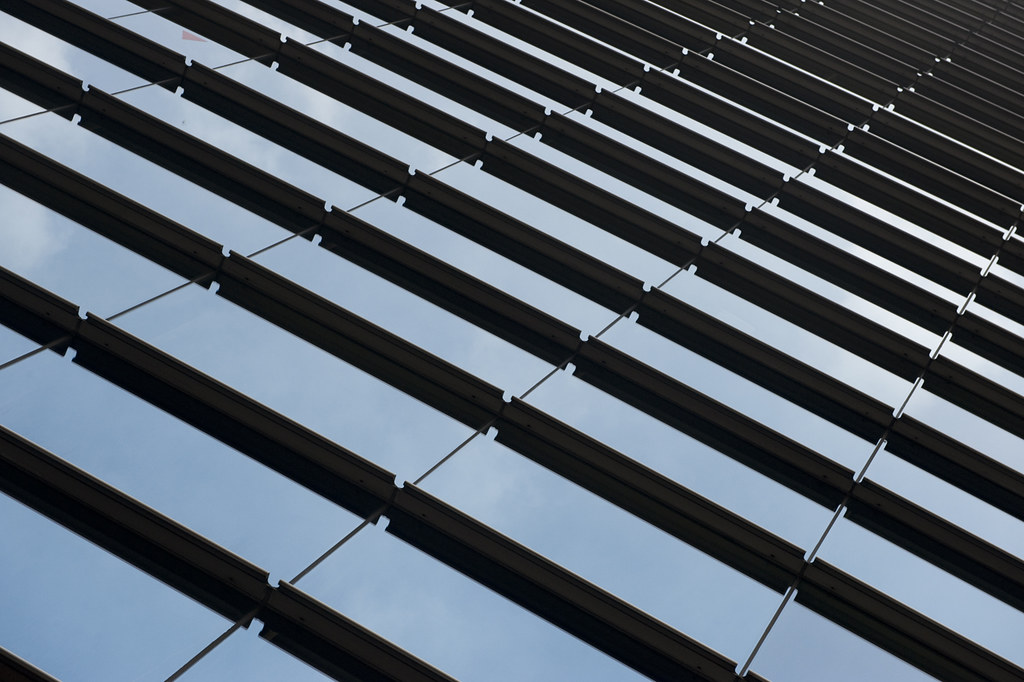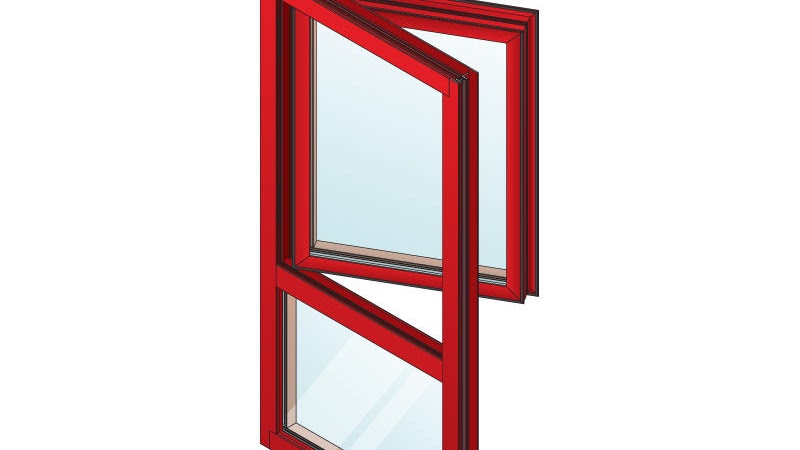Window cleaning, or window washing, is the cleaning of architectural glass used for structural, lighting, or decorative purposes. It can be done manually, using a variety of tools for cleaning and access. Technology is also employed and increasingly, automation.
Commercial work is contracted variously from in-person transactions for cash or barter, to formal tender processes. Regulations, licensing, technique, equipment and compensation vary nationally and regionally.
Tools
Chamois & scrim
Chamois is a basic method used to loosen and remove dirt, followed by a buffing with cheesecloth, or scrim.
Water & squeegee
Generally, chemicals are added to water, and a device such as a brush or cloth-covered handle is dipped into the resulting solution and used to scrub glass. A squeegee is then used to sluice the dirt and water mixture from the glass.
There are four different types of squeegees.
Window squeegee is the most famous one because it is used on all types of windows. Your house, commercial or even car windows can be cleaned with the window squeegee.
Floor squeegees are mostly used for large surfaces like floors, they're mostly used in hospitals and other large buildings.
Stiff blade squeegees are found in using grouts to tiles.
Horse scrapers are applied to in houses to eliminate sweat and dust from the layers.
Chemicals added to the solution range from dish soap and glass cleaner to Trisodium Phosphate and etching salt. In sub-freezing temperatures, anti-freezing chemicals are added to the solution to prevent it from crystallizing on the pane before it is sluiced off.
Water-fed poles
Any of a variety of types of telescopic poles, fitted at the upper end with a brush and water jets, fed either from vehicle-borne tanks of deionised water or by on-site production of deionised water using a domestic or commercial water outlet. The water is filtered by either a two-stage or three-stage filtration process, involving a carbon filter, and two de-ionization filters, or a carbon filter, a reverse osmosis membrane filter, and a de-ionization resin filter. The filtered water contains a TDS (total dissolved solids) of less than 5 ppm. (parts per million.) The brush is used to agitate the debris off the window, while spraying water, and then the brush is lifted a few inches from the glass to rinse the glass with the pure water jets. Fan jets are used for hydrophobic glass, and "pencil" jets are used for hydrophilic glass. The de-ionized water is lacking in ions, so it will pull solids off the glass and dissolve the solids into the water, aiding in the cleaning process. Because there are no solids dissolved in the water, the windows dry clear without water spots. Water-fed poles vary in length. The longest poles are about 70 feet, and can reach up to six storeys. Water-fed cleaning is also referred to as pure water cleaning. It is common in the UK and becoming common in the US.
Windows For Commercial Buildings Video
Access
Where glass is found are window cleaners, and methods of access and equipment related to both access and cleaning vary nationally and regionally.
Ladders
Ladders ranging in size from a single step to the extent (and beyond) of local regulations are used to access windows for cleaning purposes.
Supported scaffolding
Not to be confused with suspended scaffolding, these are temporary work platforms typically erected from a lower level to gain access at height.
Aerial work platforms
Aerial work platform are variously configured and powered machines, designed to deliver workers to otherwise inaccessible areas. An example of one of these machines is the scissor lift, as it is known in Australia, along with cherry pickers and spiders.
Suspended platform or cradle
Not to be confused with supported scaffolding. Devices designed for ascent and/or descent via wire rope by mechanical or manual means.
- Boatswain's chair (bosun's chair): A boatswain's chair is a single-person seat designed for controlled descent of rope. Often referred to as "rope decent systems" (RDS), these are typically anchored to a roof structure, counterweight configuration, or connecting points designed for the purpose. Note: These are always temporarily installed for the purpose of access. However, their anchor points can be either temporary or permanent.
- Suspended platform: An access platform for one or more workers with manual or motor driven devices for raising and lowering via rope. Platforms may be fitted to high rise buildings or skyscrapers, or assembled from components to suit architecture and nature of work being performed. Note: These can be either temporary or permanent. Both having their own unique governing codes and regulations. Permanent suspended platforms are often known as building maintenance units (BMU) and their platforms are also known as gondolas in Europe.
Windowsill access
Direct access to a window obtained by egress from that window. This method is still used at the Empire State Building in New York City.
History
In New York City, the window cleaning trade was established in the late nineteenth century when the first skyscrapers were built. In the early years, washers often cleaned skyscraper windows by standing on the window ledge and holding onto the frame. Leather safety belts attached to anchor bolts were introduced in the first decade of the twentieth century. Window cleaning scaffolds were introduced in New York in 1952, when the Otis Elevator Company built an electrically operated scaffold for use at Lever House. When the original World Trade Center opened in 1973, many of its windows were cleaned by machines on each tower, but these were known to malfunction and could not be used on the uppermost floors. As of 2013, only one such machine remained in use in Manhattan.
The window cleaning profession was initially dominated in New York by Polish Americans, who were successively followed by Ukrainian, Italian and Irish Americans. In more recent times, many New York window cleaners have been immigrants from South America. There were 3000 window cleaners in New York as of 1916, and between 2000 and 3000 as of 1931, but only 800 as of 1995.
Three window cleaners were working at the World Trade Center at the time of the September 11 attacks. Jan Demczur, working in the North Tower, survived and helped save five other people who had been trapped in an elevator with him. Roko Camaj and Fabian Soto, working in the South Tower, were killed.
Hazards of the trade
Risks include slipping on water or soap, and falling from heights. In 1932 in New York, an average of one out of every two hundred window cleaners was killed per year. On May 29, 1962, four window cleaners were killed when a scaffold fell at the Equitable Building. In 1993 Local 32BJ, the New York window cleaners' union, launched an apprentice training program, increasing job safety among its members, although increasing numbers of New York window cleaners are non-unionized.
Unlike in Scotland, there is no government licensing in the United States, England or Wales - this means anyone can claim to be a window cleaner. Window cleaning is considered the most dangerous job in the UK. Several window cleaners die each year, and many are injured.
Many window cleaning businesses are claiming that laws are about to come into force due to European Directive 2001/45/EC that will make ladders illegal for window cleaners. However, the government denies this stipulation, as ladder use for window cleaning is "low risk and short duration":
To clarify the situation HSE is not attempting to ban ladders or stepladders, but ladders should not be the automatic first choice of access. They should only be used after a suitable assessment of the alternatives and the prevailing site conditions. The selection process for access equipment is coming under increasing scrutiny at HSE inspections. This guidance clarifies that for short duration work like window cleaning, provided a number of well-recognised precautions are taken, ladders will remain a common tool for many jobs.
The Working At Height Regulations came into force in 2005 and does not ban ladders but merely restricts their use to safe methods, i.e. foot it by person or with a ladderstopper:
4.2.2. The feet of portable ladders must be prevented from slipping during use by securing the stiles at or near their upper or lower ends, by any anti-slip device or by any other arrangement of equivalent effectiveness. Ladders used for access must be long enough to protrude sufficiently beyond the access platform, unless other measures have been taken to ensure a firm handhold. Interlocking ladders and extension ladders must be used so that the different sections are prevented from moving relative to one another. Mobile ladders must be prevented from moving before they are stepped on.
The HSE favours the use of scaffold towers, i.e. temporary workstations, for window cleaning but acknowledges this is rather awkward:
"For some jobs, a mobile elevating work platform will be the best option. However, for many jobs, especially on domestic and small commercial buildings, risk assessment will demonstrate that because of the short duration of the work and features on the building that cannot be altered, ladders are the only realistic option."
Although WFP systems are hailed as safer than ladders, the Health and Safety Executive acknowledges that such systems spill large amounts of water which either the window cleaner or their client could slip on.
Ecology and water shortages
Another issue is how "green" window cleaning companies are seen to be. During the spring of 2006 Defra considered banning the non-essential use of water and extending their already tight restrictions to prevent the use of water-fed safer which reach up to 60 ft. Window cleaners could return to the bucket-and-mop method, because Health and Safety Working at Heights allows such for temporary access. Many window cleaners and window cleaning companies argue that their usage of water is minimal in comparison with water usages of large industry and energy companies, and that their water usage accounts for a small percentage of overall water consumption in developed countries.

Technological progress and decline in labor requirements
Much progress has been made in the area of minimizing the need for labor in this industry by use of technology. The availability of technology such as the pressure washer has made it more efficient. More recently, in high tech societies the use of fully automated robotic window cleaners is starting to become common.
Images
Are You Looking for Products
Here some products related to "Window Cleaner".
DLLL New Pure white 300 L..
Amazon.com : Lemonbest® ..
How to start a window cle..
Amazon.com : BLUETTEK LED..
Get these at Amazon.com* amzn.to is official short URL for Amazon.com, provided by Bitly
Source of the article : here


1 komentar:
Active Window Cleaners. Commercial, High Rise, Rope Access, Abseil & Multi Story Building Window Cleaning Services Perth. Fully Insured & Qualified Company
commercial window cleaners
EmoticonEmoticon